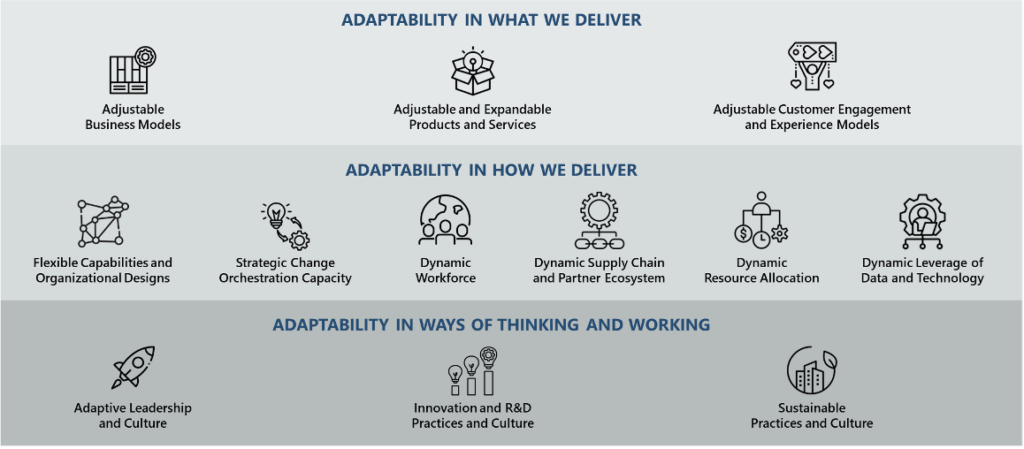
By Whynde Kuehn, S2E Transformation
The future is already here: continual change is the new normal.
Organizations today operate in—and must respond to—an increasingly complex and dynamic environment shaped by a confluence of factors. Uncertainty, disruption, and opportunity arise from an ever-growing array of rapid technological advancements, evolving customer and stakeholder expectations, and shifting market dynamics. Comprehensive regulatory changes, environmental concerns, and the evolving future of work compel organizations to innovate continuously and align with societal expectations. Furthermore, these developments unfold against the backdrop of broader global economic and social shifts.
To remain competitive, relevant, and resilient, organizations of all sizes and sectors must become fully adaptive.
An adaptive organization possesses the capacity to respond to change and evolve over time in response to its environment. Resilience is defined as “the capacity of a system, be it an individual, a forest, a city or an economy, to deal with change and continue to develop.”[1] Thus, adaptive and resilient organizations not only avoid the negative consequences of change, but leverage it to catalyze renewal, foster innovative thinking, and embrace new opportunities.
So, how does an organization become truly adaptive, functioning like a living organism that continually responds to and thrives within its environment?
CHARACTERISTICS OF AN ADAPTIVE ORGANIZATION
To understand how organizations can achieve this level of adaptability, it is essential to examine the key characteristics that define an adaptive organization. These traits enable them to thrive in dynamic environments and respond effectively to the challenges and opportunities they encounter.
We will explore the characteristics of adaptability in terms of what an organization delivers, how it is structured and operates to execute upon that delivery, and the foundational mindset of its people.
As the myriad of change pressures converge into a broader landscape of organizational transformation, it requires organizations to develop adaptability in what they deliver. This includes adjustable business models that can flex as needed—whether introducing new value propositions, serving new customer segments, or reimagining revenue streams in response to market shifts and competitive pressures. It also requires adjustable and expandable product and service offerings that can be quickly reconfigured, innovated, and adjusted to meet evolving customer needs, technological advances, and regulatory changes. Additionally, organizations need adjustable customer engagement and experience models to adapt communication channels, personalization strategies, and service delivery methods, ensuring seamless and relevant interactions as customer preferences, behaviors, and expectations evolve.
Being able to act on business direction and changes is critical; therefore, organizations must also develop adaptability in how they deliver, which is codified in their structure and operations. This includes flexible capabilities and organizational designs that provide a modular set of business building blocks, enabled by people, processes, information, and technology, which can be reused, reconfigured, and expanded to deliver new value propositions, products, and services. Additionally, the design of business ecosystems, organizational structures, decision models, and operating models must be flexible.
Organizations need to cultivate a strategic change orchestration capacity that allows them to sense and respond to change through effective coordination of teams working collaboratively across the strategy to execution spectrum. This includes maintaining a line of sight from strategy to organizational architecture and design to execution, ensuring that the organization’s design and portfolio of work can be dynamically replanned as needed to react to change.
Capabilities organize resources into executable abilities that an organization can perform, but the underlying people, processes, information, and technology must also be adaptable and reconfigurable to support evolving capabilities. Consequently, organizations also require a dynamic workforce with adaptable skills, roles, and collaborations, supported by continuous learning and engagement. Furthermore, they need a dynamic supply chain and partner ecosystem with flexible sourcing, real-time inventory management, dynamic logistics planning, and effective collaboration with partners. Organizations must also implement dynamic resource allocation to rapidly adjust budgets and teams. Additionally, they must excel at the dynamic leverage of data and technology to identify, deploy, and reuse data and technology that align with their evolving business direction and needs.
Finally, organizations must embody the mindsets that facilitate adaptability in ways of thinking and working. This includes fostering an adaptive leadership and culture where people have the foresight to anticipate changes and embrace change them as opportunities for continuous renewal. Organizations must also build robust innovation and R&D practices and culture with dedicated resources for experimentation, agile processes, cross-functional collaboration, continuous prototyping and testing, and mechanisms to rapidly scale successful innovations. Additionally, they must embrace and establish sustainable practices and a culture that form the core ways of thinking necessary for long-term operation. This involves designing for circularity and resource efficiency, reducing environmental impact, promoting social responsibility, and embedding sustainability into the design, decisions, and culture at every level of the organization.
These characteristics are summarized in Figure 1 below.

Figure 1: Characteristics of an Adaptive Organization
BUSINESS ARCHITECTURE: FOUNDATION FOR ADAPTABILITY
Business architecture is the critical foundation that enables organizations to become adaptive. While it supports the decision-making and design across every single aspect of the adaptive organization shown in Figure 1, we will explore three key ways the discipline can be leveraged. First, business architecture provides the building blocks and mindset for creating a modular or composable enterprise (Flexible Capabilities and Organizational Designs in Figure 1). Second, it plays a critical role in underpinning the end-to-end process of strategy formulation, translation, and execution (Strategic Change Orchestration Capability in Figure 1) by serving as a key connector for future state design and ensuring a clear line of sight between strategy and the portfolio of work executing it. Finally, business architecture facilitates key mindset shifts necessary to cultivate an adaptive culture (Adaptive Leadership and Culture in Figure 1).
Business architecture enables the concept of a composable enterprise by providing the modular business building blocks, with capabilities and value streams at the core, that allow organizations to design and redesign themselves with flexibility. Capabilities represent the fundamental abilities of an organization and are enabled by people, processes, information, and technology. Value streams orchestrate these capabilities to deliver value to customers/constituents, partners, and employees. By clearly defining these building blocks, organizations can reassemble capabilities in new ways, allowing them to rapidly adapt to new business models, deliver innovative value propositions, and launch new products and services.
Additionally, business architecture fosters a mindset shift toward modular design, encouraging leaders to view innovation in terms of reconfigurable components rather than siloed functions. This approach not only enhances agility but also streamlines operations. For instance, value streams can uncover opportunities to consolidate similar processes, while capabilities can identify redundant systems and resources, driving efficiency and reducing costs.
Capabilities also empower organizations to exchange and harness value effectively within business ecosystems by providing well-defined and modular components that can be easily understood and integrated across different entities. This modularity enables seamless collaboration, allowing organizations to combine complementary capabilities, co-create value, optimize shared processes, and collectively respond to market opportunities.
Business architecture is also a critical enabler of the strategy-to-execution process. The ability to effectively formulate, translate, and implement strategy with speed and scale is essential for an adaptive organization to continuously transform business direction and change into action. Business architecture plays a unique and often missing role in translating business direction into a coordinated set of actions and initiatives across the organization. (See Stage 2 for Architecture Changes shown within Figure 2.) Unlike the typically siloed responses, it fosters collaboration by aligning various teams and functions toward common goals and facilitating decision-making from an enterprise perspective. It establishes a golden thread that creates a clear line of sight between business strategy, the organizational architecture and design, and the portfolio of work. This clarity is vital for dynamically responding to changes in direction and for the agile replanning of initiatives as business needs evolve.

Figure 2: A Comprehensive Framework from Strategy to Execution
Furthermore, business architecture serves as the scaffolding that connects different teams and functions, acting as a center of gravity for collaboration and future state design. Leaders can also leverage business architecture to perform strategic governance, using capabilities and value streams as organizing constructs for making informed decisions about future states and investments.
Finally, adopting a business architecture mindset can help to cultivate an adaptive culture by catalyzing individuals to think and work differently. By shifting from a siloed perspective to one that considers what is best for the enterprise, employees make more informed decisions that align with organizational goals, enhancing adaptability and responsiveness to change. Business architecture encourages a transition from an inside-out perspective to an outside-in approach, prioritizing customer and constituent needs and focusing on delivering value. This shift not only fosters a more customer-centric mindset but also enables teams to identify opportunities for innovation and improvement. Furthermore, it promotes a culture where individuals take the time to plan, make fully informed decisions, and understand impacts from a holistic perspective, thereby overcoming the tendency to jump to immediate solutions or technology fixes.
MOVING INTO ACTION
The journey to becoming an adaptive organization requires both time and intentionality, but it is a journey that can begin today.
Assess Your Current State of Organizational Adaptability and Develop a Plan
Start by evaluating your organization’s clarity and commitment to becoming an adaptive enterprise. Utilize the characteristics outlined in Figure 1 to assess the organization’s current level of adaptability. Develop a compelling business case that articulates the vision and benefits of this transformation, and obtain leadership buy-in. Create a roadmap to guide the organization through this journey over time.
Establish and Mature Your Business Architecture Practice to Support Adaptability
Educate key stakeholders about the business architecture blueprints and knowledgebase, emphasizing the key mindset shifts they facilitate. Build a baseline of your business architecture, which should include enterprise-level value streams and capabilities developed and owned by cross-functional business experts. Start leveraging business architecture to support all adaptability characteristics and activities, and adopt a culture of testing, learning, evolving, and expanding as you progress. Over time, continue to enhance your business architecture practice and establish a center of excellence to support the organization’s need for holistic decision-making and design.
In conclusion, the journey toward becoming an adaptive enterprise is not merely an aspiration but a necessity in today’s rapidly changing, digital, and connected world. By embracing business architecture as a critical foundation, organizations can cultivate the flexibility, resilience, and collaborative mindset essential for navigating uncertainty. As they implement modular capabilities, streamline their strategy-to-execution processes, and foster an innovative culture, they position themselves not just to survive but to thrive. The time to act is now though, and by making adaptability and leveraging the principles of business architecture a priority, organizations can unlock new avenues for growth and success in an increasingly complex world.
[1] “What is Resilience?” from the Stockholm Resilience Centre: https://www.stockholmresilience.org/research/research-news/2015-02-19-what-is-resilience.html#:~:text=Resilience%20is%20the%20capacity%20of,spur%20renewal%20and%20innovative%20thinking
